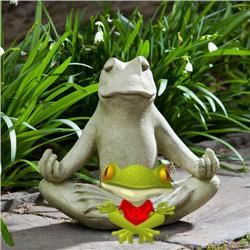With breakfast, and the small talk, finished he began with one of his famous sayings, "Irwin, a frog's joy must spring from within. No one can make him joyous. He must choose joyfulness. But that isn't always easy in our competitive world. Everyone wants to be more, to do more, to have more. But that isn't true joy, Tadpole. Take me, for example. I can find joy in a perfectly-brewed cup of tea." I knew what he meant. It's difficult not to become caught up in today's society where it's ingrained in us to seek out 'intense delights;' bigger houses, faster cars, more money, more status. According to Dharma (and he's one wise frog so I believe him) when we go for all the bells and whistles, we're missing the point of true joy. We are setting the happiness bar too high. Sure, we can achieve all the worldly success but, before we know it, something better will come along and we'll begin to want that. The cycle is never-ending.
Setting a high bar for intense happiness works against our true well-being. Why? because when set our happiness bar too high, ad we can't or don't achieve it, we wind up with a feeling of failure, or not good enough. And that those negative feelings don't lead to true well-being or joy. We find what we look for. Scientists call this phenomenon "confirmation bias." Our brains tend to see only what it believes to be true and completely misses all that doesn't confirm to its hypothesis. So what's the alternative? Dharma tells me to aim for paying attention; noticing how we really feel at the moment - and embracing all those diverse feelings.
Research has shown that over-pursuing happiness can actually be detrimental to our emotional and physical health. Yep. There is such a thing as working too hard to find happiness. Frogs, and humans, who have "emodiversity" - meaning they experience a full-range of emotions including anger, sadness, fear, and worry, are actually healthier than those who emotions all tend towards the positive. One study of 35,000 humans, showed that those who ranked high in emotional diversity were less likely to be depressed than those who worked hard to stay in their "happy zone," dismissing their other emotions. Apparently, it's OK to feel bad once in awhile. Whew! That's a big relief....
In another study in Belgium, it was found that those humans with greater emotional diversity used fewer medications, went to the doctor less often, exercised more, ate better, and generally were in better health than their "happier" counterparts.
Going for the "gusto"...that intense happiness we get when we acquire a new toy or upgrade our status, can affect our creative juices, as well. Happiness guru, Mark Allen Davis, found in one study that when humans experience extreme or intense happiness, they tend to not tap into their creativity as much. That would explain all the amazing works of art by struggling artists, like van Gogh. That doesn't mean that you need to wallow in sadness to be creative. It simply means that being open to experiencing all emotions can help the creativity flow. It's never helpful to have only "one note."
Too, those that live on the upper end of the happiness scale, aren't as adaptable to change and are less flexible when it comes to problem-solving. For them, it's harder to adjust when things do "go south." Researcher Iris Mauss, and her colleagues, have shown with their studies that sometimes people who chase happiness to an unrealistic degree, can wind up with serious disappointment. So, it seems, it's better to try and not be quite so happy all the the time.
Dharma ended our lesson today by telling me that it's OK to feel just OK. He tells me that when we stop looking for those "ecstatic states" (which can be like a drug...the more have of them, the more we want) we can find true joy in commonplace moments. And that kind of joy is real; the kind that brings us a true sense of well-being. When we feel connected to the world around around us, we feel safer and more secure. It's not a fleeting emotion, but one that can, and will, endure no matter what is going on around us.

 RSS Feed
RSS Feed